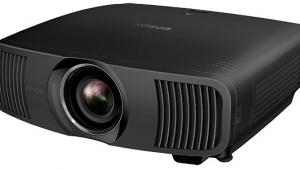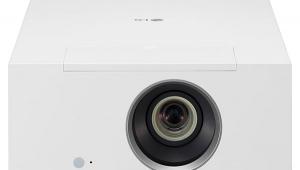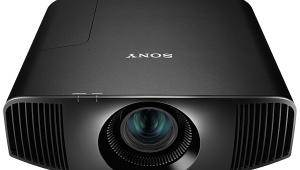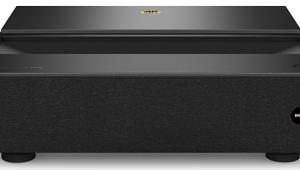Epson PowerLite Pro Cinema 1080p

Three years ago we reviewed Sony's Qualia 004, the first 1080p, three-chip front projector that came through our doors. Not only was that rig $30K, at the time that wasn't even considered hideously expensive for such a beast. Premium 720p single-chip projectors were running at $15K-$20K, and the big Sony didn't seem that far out of line.
Now, here we are in 2007. Sub $5K 1080p front projection is rapidly becoming one of the most hotly competitive categories there is.
Epson's PowerLite Pro Cinema 1080p is the third 1080p three-chip front projector we've reviewed in the last six months at under $5K. And as you'll read, this $4K projector isn't just a stripped down loss leader. It's fairly loaded, using the latest Epson LCD chips, and a ton of other useful features- features that not so long ago were sacrificed in lower priced projectors. Let's dig in and see what we've got here.
What It Is
The Epson is a curvaceous, stylish looking PJ, a far cry from the no-frills shoeboxes that mostly populate the lower price points in front projection. Plusses include vertical and horizontal lens shift, which makes installation far easier and opens front projection to an even wider number of end users. The zoom, focus and lens shift adjustments are all manual, no motorization. The zoom range is extremely generous- with an 87" wide, 16:9 screen the specified range is 9.8' to 20.9' from the lens to the screen.
This projector's most critical feature limitation is its single HDMI input. Although switching HDMI sources through an AVR or pre/pro is becoming more popular, even at this price point we'd really like to see at least two HDMI inputs.
The Epson will accept 1080p/24 sources, but according to Epson only displays at 1080p/60. Displays that can output 1080p/24 signals at 48Hz, 72Hz or 96Hz can provide a subtly smoother image by eliminating the "judder" associated with the 3/2 pulldown required to output film's 24p native images at 60Hz.
Another significant accoutrement here is the inclusion of a dynamic iris system. LCD and LCoS projectors have, until recently, suffered in comparison to most DLPs in the critical areas of blacks and contrast ratio. Dynamic irises in these devices have turned the tables. To oversimplify, projectors with auto iris systems analyze the light levels in the image and open and close the iris accordingly to maximize the contrast in any scene (gamma and other complex electronic adjustments are used in conjunction with the physical iris adjustments). When done well dynamic irises are incredibly effective at deepening blacks and increasing contrast.
In addition this projector is ISFccc-certified, which means it has readily available adjustments for proper grayscale tracking and a score of independent memories (optimized for Day and Night watching) to store these adjustments and recall them at the push of a button. There are more memories here than a sane man would ever use, and going further, more than insane people like TJN and myself could use.
The Two Towers
This is only one of two 1080p front projectors recently introduced by Epson. The PowerLite Home Cinema 1080p costs only $3K, and gives up precious little to its big brother, at least on paper. Looking at the sales lit the only apparent differences I saw are that the Pro Cinema includes an extra bulb, a ceiling mount kit, and the additional ISFccc memories.
Setting It Up
The Pro Cinema has you start by selecting a Color Mode, which is essentially a preset of image adjustments with brightness, contrast and color "optimized" for various viewing conditions. Tom Norton used the HD color mode as a base for two sets of calibrations he did before shipping the projector to me for review, which the manual touts as offering "images that are close to those in professional-use broadcast monitors." So, my observations here were based on that mode as well.
In the Menu system there are the usual adjustments for Brightness and Contrast, but the other adjustments aren't quite as obvious. Although Sharpness can be operated in the usual fashion, called Standard here, an Advanced adjustment allows four separate adjustments in a range of plus or minus 10, for both Thick and Thin Lines in both the Horizontal and Vertical planes.
Absolute Color Temp is adjustable over a range of 5000K to 10000K. Set to 6500K out of the box, Tom Norton measured a grayscale that was within 100K of that target. Excellent out of the box performance in other words, and as the measurements show Tom was able to dial it this Epson in even closer to the D6500 reference standard. Grayscale tracking here is as close to perfection as we see, just as you'd expect from a projector with the ISF's name associated with it.
Next is an utterly superfluous adjustment, Skin Tone ("S. Tone" in the menu). According to the manual this uses the Epson Cinema Filter to adjust "the color of projector skin tones." Increasing this adjustment increases green and decreasing it increases red tones. This projector has some of the most gorgeous colors I've ever seen on a digital display- all S Tone does is undermine that outstanding performance.
Pre-loaded are gamma curves of 2.0, 2.1, 2.2, 2.3 and 2.4, plus a Customized option that allows you to set a custom gamma curve by eye in selected areas of the screen, or adjust it using a graph. The by eye method is a road to ruin, pure and simple, so don't do it! Even the second is difficult at best. I found nothing wrong with the 2.2 setting and recommend strongly that you get by with one of the five presets.
In addition to the traditional Brightness adjustment controlling the projector's black level there is a "Brightness Control" that is just a traditional lamp power setting with a confusing choice in naming. Last but hardly least is the Auto Iris, which has settings of only On or Off, no additional provisions or fixed positions of any kind. As you'll read I used On at all times.





























































